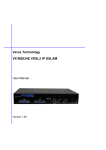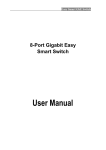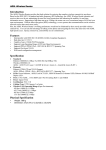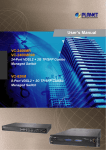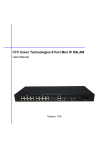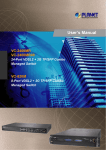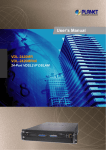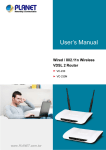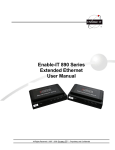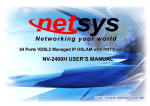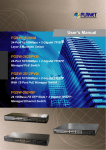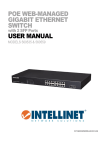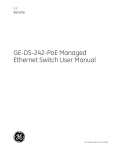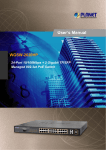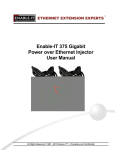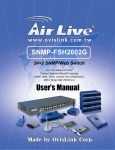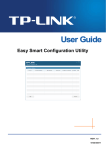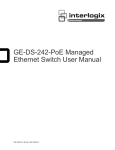Download Enable-IT 8924 DSLAM Ethernet Extender User Manual
Transcript
Enable-IT
8924 DSLAM
Ethernet Extender
User Manual
All Rights Reserved 1997 - 2015 ENABLE-IT - Proprietary and Confidential
Copyright © 1997-2014 Enable-IT, Inc. All rights reserved. No part of this
documentation may be reproduced in any form or by any means or used to make
any derivative work (such as translation, transformation, or adaptation) without
written permission from Enable-IT, Inc.
Enable-IT, Inc. reserves the right to revise this documentation and to make
changes in content from time to time without obligation on the part of Enable-IT,
Inc. to provide notification of such revision or change.
Enable-IT, Inc. provides this documentation without warranty, term, or condition
of any kind, either implied or expressed, including, but not limited to, the implied
warranties, terms or conditions of merchantability, satisfactory quality, and fitness
for a particular purpose. Enable-IT, Inc. may make improvements or changes in
the product(s) and/or the program(s) described in this documentation at any time.
If there is any software on removable media described in this documentation, it is
furnished under a license agreement included with the product as a separate
document, in the hard copy documentation. If you are unable to locate a copy,
please contact Enable-IT, Inc. and a copy will be provided to you.
UNITED STATES GOVERNMENT LEGEND
If you are a United States government agency, then this documentation and the
software described herein are provided to you subject to the following:
All technical data and computer software are commercial in nature and
developed solely at private expense. Software is delivered as "Commercial
Computer Software" as defined in DFARS 252.227-7014 (June 1995) or as a
"commercial item" as defined in FAR 2.101 (a) and as such is provided with only
such rights as are provided in Enable-IT, Inc.'s standard commercial license for
the Software.
Technical data is provided with limited rights only as provided in DFAR 252.2277015 (Nov 1995) or FAR 52.227-14 (June 1987), whichever is applicable. You
agree not to remove or deface any portion of any legend provided on any
licensed program or documentation contained in, or delivered to you in
conjunction with, this User Guide.
Unless otherwise indicated, Enable-IT, Inc. registered trademarks are registered
in the United States and may not be registered in other countries.
All Rights Reserved 1997 - 2015 Enable-IT, Inc.
Page 2 of 73
COPYRIGHT BY ENABLE-IT, INC. ALL RIGHTS RESERVED
TABLE OF CONTENTS
CHAPTER 1 INTRODUCTION
1.1 PACKAGE CONTENTS
1.2 FEATURES
1.3 SPECIFICATIONS
CHAPTER 2 HARDWARE INSTALLATION
2.1 FRONT PANEL
2.1.1 CONNECTORS
2.1.2 LED INDICATORS
2.1.3 RESET BUTTON
2.2 PIN ASSIGNMENT OF THE RJ-21 CABLE
CHAPTER 3 WEB CONFIGURATION
3.1 ADMINISTRATION
3.1.1 IP ADDRESS
3.1.2 SWITCH SETTING
3.1.3 CONSOLE PORT INFORMATION
3.1.4 PORT CONFIGURATION
3.1.5 SNMP CONFIGURATION
3.1.6 SYSLOG SETTING
3.1.7 ALARM CONFIGURATION
3.1.8 TEMPERATURE & FAN STATUS
3.1.9 FIRMWARE UPDATE
3.1.10 CONFIGURATION BACKUP
3.1.11 SNTP SETTING
3.2 L2 FEATURES
3.2.1 VLAN CONFIGURATION
3.2.1.1 STATIC VLAN
3.2.1.2 GVRP VLAN
3.2.1.3 QINQ VLAN
3.2.2 TRUNKING
3.2.2.1 FORWARDING & FILTERING
3.2.3.1 IGMP SNOOPING
3.2.4.1 SPANNING TREE
3.2.5.1 SYSTEM CONFIGURATION
3.2.6.1 PERPORT CONFIGURATION
3.2.6.2 INSTANCE
3.2.6.3 INTERFACE
3.2.6.4.1 DHCP RELAY & OPT.82
3.2.6.5 DHCP OPTION 82
3.2.6.6 DHCP RELAY
3.2.6.7 DHCP OPTION 82 ROTUER PORT
3.2.6.8 DHCP OPT. 82 PORT TABLE
3.3 ACL
3.3.1 IPV4
3.3.2 NON-IPV4
All Rights Reserved 1997 - 2015 Enable-IT, Inc.
2
3
5
5
5
7
9
9
9
10
10
11
12
15
15
16
19
19
23
28
28
29
29
30
31
32
32
33
35
38
40
42
44
45
46
48
48
49
49
50
50
51
51
51
53
54
Page 3 of 73
3.3.3 BINDING
3.4 SECURITY
3.4.1 SECURITY MANAGER
3.4.2 MAC LIMIT
3.4.3 802.X CONFIGURATION
3.5 QOS
3.5.1QOS CONFIGURATION
3.5.2 TOS/DSCP
3.6 MONITORING
3.6.1PORT STATUS
3.6.2 PORT STATISTICS
3.7 VDSL
3.7.1 CONFIGURATION
3.7.2 PROFILE TABLE
3.8 RESET SYSTEM
3.9 REBOOT
TECHNICAL SUPPORT
WARRANTY REPAIR
RETURN POLICY
LIMITED WARRANTY
CONTACT US
All Rights Reserved 1997 - 2015 Enable-IT, Inc.
54
56
56
57
58
60
61
63
63
64
65
66
66
68
69
69
70
70
70
71
73
Page 4 of 73
1. Introduction
Thank you for choosing the Enable-IT 8924 Extended Ethernet DSLAM. These
products are the cost-effective switching solution ideal for small businesses,
Telecom, ISP (Internet Service Provider), or SI (System Integration) for a
competitive network edge. The 8924 VDSL2 DSLAM is a 24-port solution with a
2-port Gigabit Ethernet combo interface (TP and SFP) in a 1.5U height design.
This concentrator offers the benefits of high speed connectivity with an intuitive
management system, robust layer 2 features with advanced security settings,
and a reliable hardware design with monitoring system integration.
1.1 Package Contents
The Enable-IT 8924 Extended Ethernet DSLAM includes the following items:
(1) Enable-IT 8924 VDSL2 DSLAM Concentrator
(1) Enable-IT 8924 User Manual
(1) Country Specific Power Cord
(1) DB9-RJ-45 Serial Console Cable
(1) 19” Set of Rack Mountable Brackets and Screws
(4) Rubber Feet for storage
1.2 Features
(24) 10/100BaseX Ethernet ports (2) 10/100/1,000BaseX Ethernet ports and
Ethernet switch controller
Supports SMII for 10/100BaseX ports
Supports GMII/MII/TBI for 10/100/1,000BaseX ports
All packet buffer and control data memory embedded
Flow control support:
o 802.3x pause frame uses for full-duplex ports
o Collision-based back-pressure for half-duplex ports, carrier-based
back-pressure not supported
Half and full-duplex operations:
o Full-duplex operation supported on 10/100/1,000Mbps ports
o Half-duplex operation supported on 10/100Mbps ports only
Supports 802.1D bridge self-learning, storing up to8L + 256 unicast or
multicast addresses
Supports automatic age-out period between 1 to 1,000,000 seconds
Broadcast storm filtering based on ingress port bandwidth
HOL blocking prevention
Deadlock relief
All Rights Reserved 1997 - 2015 Enable-IT, Inc.
Page 5 of 73
Auto-polling via MDC/MDIO management interface for auto-configuration of
speed, duplex mode, and flow control capability of all Ethernet ports
9K+ jumbo packets supported on per port and per VLAN basis
Supports layer 2 source filtering
Supports 802.1D Spanning Tree Algorithm and Protocol, 802.1w Rapid
Reconfiguration
Flexible per-port VLAN classification option supports port-based VLAN
domain and 802.1Q VLAN domain simultaneously
Supports independent VLAN Learning (IVL) and Shared VLAN Learning (SVL)
Supports 802.1X Port-based Network Access Control
Supports 802.3ad Aggregation of Multiple Link Segments
o Statistical load-balancing algorithm may be configured to be the
function of source and destination MAC addresses, ingress port ID,
source and destination IP addresses, and TCP/UDP source and
destination ports
Supports BPDU, LACP, EAPOL suppression based on per port configuration
Supports 64 VLAN-dependent Spanning Trees
Supports IP multicast and snooping of IGMP and IP multicast routing protocol
PDU
o Including IGMP, CBT, OSPF, and PIM v2
IP multicast packets may be forwarded within single VLAN or across multiple
VLANs
o Cross-VLAN mode allows each egress port to have its own tag rule
and VID for IP multicast packets
Port mirroring
Supports 802.1p Traffic Priority
ToS-to-802.1p priority mapping is enabled on per-VLAN basis
Flexible per-port prioritization option:
o The prioritization result can be made to other switches in the network
by replacing priority field in VLAN tag
Four priority egress queues per port
Scheduling algorithms: strict priority or weighted round robin
Four RMON groups (1,2,3,9)
Supports MIB of RFC1213, 1573, 11757, 1643, 2233
Programmable LED output provides:
o Serial LED output provides basic status of all Ethernet ports, or
o Port 24/25 link status and broadcast storm indicator
MAC address table synchronization assistance
Asymmetric VLAN membership for better network security:
o Distinguish ingress VLAN member and egress VLAN member
o Prevents a station to sneak in VLANs set up for common servers
Improved VLAN ingress rules may specify:
o Filtering untagged packets or VLAN tagged packets
o Filtering packets received on non-ingress VLAN member ports
Supports insertion of 2nd tag with different TPIC to VLAN-tagged packets
All Rights Reserved 1997 - 2015 Enable-IT, Inc.
Page 6 of 73
Port-based ingress rate policing and egress rate pacing
Supports Layer 2/3/4 (Layer 2+) classification:
o Standard-length IPv4 packets can use layer 2 VLAN-tag ID, IP protocol,
Source IP, Destination IP, TCP/UDP Destination Port and Source Port,
and TCP SYN field for classification
o Non-standard or non-IPv4 packets use part of layer 2/3 header for
classification
o Up to 256 different classification rules supported
o Each classification rule is associated with an action code
o Packet and byte counters for all classification rules to record match
statistics
Supports Layer 2+ based VLAN classification scheme:
o IP subnet based and Protocol-based VLAN achievable by means of
layer 2+ classification
o May override VID in VLAN-tag
Supports filtering, redirecting, and/or mirroring of packets based on Layer 2+
classification result
o Redirects IPv6 packets to IPv6-capable network devices
SMAC/SIP binding for IPv4 packets can be implemented
Layer 2+ packet classification result ay be used to define packet priority
Priority adjustment based on per port profile and per VLAN property
o Priority of a packet can be upgraded or downgraded based on setting
of the ingress port and VLAN
Supports protected port, protected port group, and unprotected port group
VID in transmitted packets can be replaced by a fixed VID associated with the
egress port
o The VID to be swapped in by egress port can be different than the
default VID for untagged ingress packets
CPU interface: alternatively
o 32-bit 33MHz PCI interface
o 16-bit PIO interface with three DMA controllers
Programmable byte-swap capability of MIB counter memory access
Programmable event triggered interrupts allowing software to respond to or
ignore an array of exceptions
332-ball PBGA package
1.8V core and SRAM voltage, and 3.3V pad voltage
All Rights Reserved 1997 - 2015 Enable-IT, Inc.
Page 7 of 73
1.3 Specifications
Hardware
Case:
1.5U High Pizza-Box Type Enclosure
Interface:
24 VDSL2 Ports
(2) RJ-45 100/1,000Mbps Ethernet Combo Ports
Management Ethernet
(1) RS-232 Serial Console
POTS Splitter
LED Indicators:
SYS, ALM, LINK, ACT
(24) VDSL LEDs
Standards Support:
VDSL2 ITU-T G.993.2
VDSL2 Profiles: 8a, 8b, 8c, 8d, 12a, 12b, 17a and 30a
802.d L2 Bridging
DHCP Server/Client/Relay
IEEE 802.1q VLAN (port-based VLAN and Protocol-Based VLAN)
VLAN Stacking (Q-in-Q)
IEEE 802.1p Spanning Tree Protocol (STP)
IEEE 802.3ad Link Aggregation
Protocol Support:
IGMP Snooping/Proxy v1, v2 and v3
Multicast Forwarding with IGMP Snooping v1 and v2 (RFC 1112 and RFC
2236)
Multicast MAC address mapping
Up to 512 Multicast Channels
Profile-based Multicast Access Control (up to 24 profiles)
Fast and Normal Leave Modes
Security:
L2 Frame Filtering by MAC Addresses
L3 Frame Filtering by IP Addresses, protocol ID, and TCP/UDP
DHCP and ARP Broadcasting Frames Filtering
Support Secured Forwarding
All Rights Reserved 1997 - 2015 Enable-IT, Inc.
Page 8 of 73
Management:
Support OAM&P Functions
Support VLAN Priority Queue (IEEE 802.1p)
Support CoS, ToS, DSCP, etc.
Support SNMP v1/v2/v3 and MIB I/II
Web-based Graphical User Interface, Telnet, CLI and SSH
Operating Requirements:
Operating Temperature: 14°F to 122°F (-10°C to 50°C)
Storage Temperature: -40°F to 158°F (-40°C to 70°C)
Relative Humidity: Up to 95% (non-condensing)
2. Hardware Installation
This section shows the front image of the 8924 DSLAM and how to install the
hardware.
2.1 Front Panel
The 8924 DSLAM includes all connectors and LED indicators on its front panel
so only a few installation steps are required to build the network solution.
2.1.1 Connectors
POTS – The 8924 DSLAM includes (24) built-in splitters, POTS, with a
Telco-50/RJ-21 cable for telephone services.
LINE – Line is for connecting (24) VDSL2 ports with a Telco-50/RJ-21
cable.
ALARM – For alarm inputs and outputs.
CONSOLE – Users are able to access the 8924 DSLAM locally with the
CONSOLE port. Via the CONSOLE ports, users are able to configure the
8924 DSLAM with menu-driven interface with any terminal emulation
program, such as, Hyperterminal and Terterm. (115200, 8, None, 1, None)
All Rights Reserved 1997 - 2015 Enable-IT, Inc.
Page 9 of 73
GE1 & GE2 (Gigabit Ethernet 1 & 2) – For connecting Gigabit Ethernet,
the 8924 DSLAM provides Gigabit Ethernet combo interfaces, TP and
SFP.
o TP: 10/100/1,000 BaseT copper (RJ-45 connector).
o SFP: 1000 Base-SX/LX mini-GBIC slot.
POWER – The connector is for 100V ~ 240V AC power inputs
(50Hz~60Hz, 1.5A).
2.1.2 LED Indicators
Blinking
VDSL LINK (1 ~ 24)
VDSL2 link is active
(transmitting data or
training)
RUN/ALARM
System up
PWR
GE1/GE2
On
Off
VDSL2 link is
ready
VDSL2 link is
down
Alarm is detected
No alarm
Power On
Power Off
LINK/ACT
SPEED
2.1.3 Reset Button
The reset button allows the users to reboot the 8924 DSLAM or load the default
settings.
All Rights Reserved 1997 - 2015 Enable-IT, Inc.
Page 10 of 73
Press the reset button for
Action
1 ~ 5 seconds
Reboot the IP DSLAM
Load the default settings
2.2 Pin Assignment of the RJ-21 Cable
PIN
COLOR
PORT
PIN
COLOR
PORT
PIN
COLOR
PORT
1
Black
P24
9
White
P16
17
White
P8
26
Orange
34
Brown
42
Gray
2
Black
10
White
18
Red
27
Blue
35
Green
43
Blue
3
Red
11
White
19
Red
28
Gray
36
Orange
44
Orange
4
Red
12
White
20
Red
29
Brown
37
Blue
45
Green
5
Red
13
White
21
Red
30
Green
38
Blue
46
Brown
6
Red
14
White
22
Red
31
Orange
39
Orange
47
Gray
7
Red
15
White
23
Black
62
Blue
40
Green
48
Blue
8
White
16
White
24
Black
33
Gray
41
Brown
49
Orange
P23
P22
P21
P20
P19
P18
P17
All Rights Reserved 1997 - 2015 Enable-IT, Inc.
P15
P14
P13
P12
P11
P10
P9
P7
P6
P5
P4
P3
P2
P1
Page 11 of 73
3. Web Configuration
The 8924 DSLAM allows users to manage and change configurations with a
web browser interface. Users are able to login to the web management system
with any standard web browser, such as, Internet Explorer, Firefox, Safari,
Chrome, etc.
Default IP Address
192.168.0.100
Default User Name
admin
Default Password
admin
Table 1 Default Login Information
Note: Please make sure the IP address is correct once the IP of the
management web site is changed.
Once users are able to login to the web management page successfully, the
login message box will pop up as the following image.
Once the correct login authentication information is inputted, the main page of
the management system will appear like the following image.
All Rights Reserved 1997 - 2015 Enable-IT, Inc.
Page 12 of 73
The Home page of the management system includes three major sections.
1. Title Section
This section indicated the model name of the device.
2. Menu Section
The Menu section is located on the left hand side of the page and users are
allowed to change the configuration and review the status of the device by
interacting with this section.
All Rights Reserved 1997 - 2015 Enable-IT, Inc.
Page 13 of 73
3. Information Section
The Information section present the real-time LED status and the current status
of the 8924 DSLAM.
The following sections will introduce users to the features of the 8924 DSLAM.
Administration (3.1)
L2 Features (3.2)
ACL (3.3)
Security (3.4)
QoS (3.5)
Monitoring (3.6)
VDSL (3.7)
Reset System (3.8)
Reboot (3.9)
All Rights Reserved 1997 - 2015 Enable-IT, Inc.
Page 14 of 73
3.1 Administration
The Administration section is for users to manage the 8924 DSLAM, including
the IP address, switch settings, port configuration, etc. It includes the following
detailed functions:
3.1.1
IP Address
Switch Setting
Console Port Info
Port Configuration
SNMP Configuration
Syslog Settings
Alarm Configuration
Temperatures & Fan Status
Firmware Update
Configuration Backup
SNTP Setting
IP Address
All Rights Reserved 1997 - 2015 Enable-IT, Inc.
Page 15 of 73
The IP Address function includes four criteria which users are allowed to change.
3.1.2
DHCP mode
o Disable or enable DHCP mode
o The value of this mode will decide whether the IP address is a
static IP address or a dynamic IP address.
IP Address
Subnet Mask
Default Gateway
Switch Setting
The Switch Setting present information of the switch in the following subfunctions. Note only the Misc Config section allows users to change the settings
of the switch.
Basic
In the Basic tab, the basic information of the 8924 DSLAM is presented.
o Model Name
o Description
o MAC Address
o Firmware Version
o Board Type
o Hardware Version
All Rights Reserved 1997 - 2015 Enable-IT, Inc.
Page 16 of 73
Module Info
The Module section shows the information of the Gigabit uplink ports, Gigabit
Ethernet 1 and Gigabit Ethernet 2.
Note: in the following contents, these two uplinks will be called Mod1 and
Mod2.
Misc Config
Users are allowed to modify the following details of the switch.
o MAC address age-out time
This value is for setting up how many seconds that an inactive
MAC address remains.
o Turn on port interval
This value for setting up the time interval that the CPU port should
be enabled after flooding attacks. Note: 0 means never enable the
CPU port.
Broadcast
storm filter mode
o
All Rights Reserved 1997 - 2015 Enable-IT, Inc.
Page 17 of 73
This feature is to set up the threshold value of broadcast traffic for
ports.
Options: off, 1/2, 1/4, 1/8, 1/16 (Note: the value is the percentage
of the ports ingress bandwidth used by broadcast traffic.
o Broadcast storm filters packets select
This option allows users to choose the type of the target packet for
broadcast storm filter mode.
If there is no type chosen, this means broadcast storm filter mode
is off.
Options: broadcast packets, IP multicast, control packets, and
flooded unicast/multicast packets.
o Collisions retry forever
This function will allow users to choose how many times the 8924
DSLAM should retry when a packet meets a collision.
Disable, 16, 32 or 48 collision number.
Note: when the function is disabled, this means the 8924 DSLAM
will retry for 6 times before packets are dropped. Otherwise, it will
retry continuously until the packet is sent successfully.
o Hash algorithm
This option is for choosing a hash algorithm for MAC address table.
CRC-Hash or DirectMap.
o IP/MAC binding
This feature allows user to enable or disable IP/MAC binding
function.
Enable or disable.
o 802.1x protocol
802.1x protocol is able to enable or disable via this option.
Enable or disable.
Users are able to save the modified settings by clicking on the “Apply” button.
“Default” button is for restoring the default settings. The “Help” button will
provide some information about the features with another window.
3.1.3
Console Port Information
All Rights Reserved 1997 - 2015 Enable-IT, Inc.
Page 18 of 73
This section is for users to review the settings of the console port, which allows
users to connect and manage the 8924 DSLAM I the Command Line Interface
(CLI) mode.
Connect to PC via DB9-RJ45
console cable.
3.1.4
Port Configuration
The Port Configuration section includes four detailed functions of the 8924
VDSL2 ports and Gigabit Ethernet uplink ports:
Port Controls
Port Sniffer
Protected Port
VDSL Port Status
Port Controls
All Rights Reserved 1997 - 2015 Enable-IT, Inc.
Page 19 of 73
The Port Control allows users to configure the Gigabit Ethernet uplink ports and
trunking ports if there exists any. The following parameters can be adjusted:
o State
This option will enable or disable the selected port.
Enable or Disable.
Note: Disable means to turn off the selected port; and this means
there will be no traffic going through this port.
o Negotiation
Users are able to decide whether the Gigabit Ethernet uplink ports
should be auto-negotiable or not.
Options: auto or force
Note: If force mode is selected, users have to provide the
information of Speed and Duplex.
o Speed
Users can setup the speed of the Gigabit Ethernet uplink ports in
this function.
10, 100, 1000Mbps
o Duplex
Half or Full
o Flow Control
Options: enable or disable
Enable: send a PAUSE signal to the sender and halts the traffic for
a period of time.
Disable: drop the exceed packets when there are too any packets
to process.
o Rate Control
Users are able to set up the specific rate for both ingress and
egress ports. Therefore, the 8924 DSLAM will control the rate to
meet the specified rate.
Note: the valid rate range is 0 ~ 8000; and the unit is 128Kbps.
o Security
This function is to decide whether the 8924 DSLAM will forward all
incoming packets from both secured MAC addresses and unknown
MAC addresses.
Options: enable or disable
Enable: only packets from secured MAC addresses will forwarded.
Disable: all packets will be forwarded.
o BSF
BSF stands for Broadcast Storm Filtering. It is able to enable or
disable this function by port.
Options: enable or disable
o Jumbo Frame
Uses are able to choose whether the 8924 DSLAM forwards jumbo
frame packets or not.
Options: enable or disable
All Rights Reserved 1997 - 2015 Enable-IT, Inc.
Page 20 of 73
Port Sniffer
The Port Sniffer setting is for monitoring a target port by mirroring or copying
the data of the port and forwarding to an assigned port.
o Sniffer Type
Options: Disable, Rx, TT, or Both.
Users are able to choose what kind of data they would like to
monitor.
o Analysis Port
This port is for assigning the port which should receive the data.
The analysis port will accept only copied packets from the
monitored port.
o Port & Monitor
This port is for assigning what port the users would like to monitor.
Protected Port
The Protected Port isolated a protected port from its neighbor ports and other
ports in different protected groups. However, it is allowed for a protected port
to communicate with other unprotected ports. By setting up protected ports, it
All Rights Reserved 1997 - 2015 Enable-IT, Inc.
Page 21 of 73
is able to ensure that there is no traffic, such as unicast, broadcast, or
multicast, between ports on the 8924 DSLAM.
This function provides two protected port groups. Uses are able to
choose ports and assign to either group 1 or group 2.
o Options:
Protected
- Click on the corresponding checkbox to select a port.
Group 1
- Click on the corresponding radio button for assigning a group.
Group 2
- Click on the corresponding radio button for assigning a group.
VDSL Port Status
The VDSL Port Status allows the users to monitor the current information of
each VDSL port, such as, status, upstream rate, downstream rate, SNR
margins for upstream and downstream, and firmware version. In addition, it
includes the Advance button for checking the details of the selected port in
another window, as the following.
All Rights Reserved 1997 - 2015 Enable-IT, Inc.
Page 22 of 73
3.1.5
SNMP Configuration
The SNMP setting stands for Simple Network Management Protocol, which is a
standard protocol for managing network devices. SNMP is used commonly in
Network Management Systems (known as NMS) to monitor network devices. In
addition, MIBs (Management Information Bases) is a kind of file which is used to
store all the data of managed network devices in NMS according to SNMP
standard protocols.
The 8924 DSLAM supports three version of SNMP: SNMPv1, SNMPv2c, and
SNMPv3. In the SNMP Configuration page, it includes the following sections.
System Options
o Name
The name of the 8924 DSLAM
o Location
The location of the switch
o Contact
The contact information (the name of a person or organization)
o SNMP Status
Options: Enable or disable
This option is for enabling or disabling SNMP function.
All Rights Reserved 1997 - 2015 Enable-IT, Inc.
Page 23 of 73
Community Strings
The Community Strings section is for setting up the password for accessing
SNMP system.
o Current Strings
The list of existing password strings
o New Community String
Information on a new password
String: password
Options: RO (read only) or RW (read and write)
o Add
Add button: for adding new information on the right hand side of the
table to the community list.
o Remove
Remove button: for removing a password from the left hand side of
the table.
Trap Manager
o Current Managers
The list of existing SNMP servers.
o New Manager
The information of a new trap manager.
IP Address: the IP address of the trap manager.
Community: the password for accessing the trap manager.
o Add
For adding new manager.
o Remove
For removing the information of the existing manager.
All Rights Reserved 1997 - 2015 Enable-IT, Inc.
Page 24 of 73
SNMPv3 Group
o Current Strings
The list of current SNMPv3 groups.
o SNMP Group
Group Name: the name of the SNMPv3 group.
V1/V2c/USM: the security model of this group.
Security Name: the security name string of this group.
o Add
For adding new a SNMPv3 group.
o Remove
For removing an existing SNMPv3 group.
SNMPv3 View
The SNMPv3 View is to offer or deny access to the complete features list or parts
of features list of the 8924 DSLAM.
o Current Strings
The name of the current SNMPv3 views.
o SNMP View
View Name: the name of the new SNMPv3 view.
Included/Excluded: the OID should be included or excluded for the
SNMP view.
View Subtree: the feature OID of this view.
View Mask: the subnet mask of this view.
All Rights Reserved 1997 - 2015 Enable-IT, Inc.
Page 25 of 73
o Add
For adding the new SNMPv3 view.
o Remove
For removing a selected SNMPv3 view from the current strings
table.
SNMPv3 Access
The SNMPv3 Access section is for managing SNMPv3 access control, which is
different from the access control defined by SNMPv1 and SNMPv2. SNMPv3
access sets up SNMP access levels based on contexts, groups and users, rather
than on IP addresses and community strings.
o Current Strings
The list of current SNMPv3 access list
o SNMP Access
Group Name: the group name of the new SNMPv3 access
V1/V2c/USM: the security model
- V1: Reserved for SNMPv1
- V2c: Reserved for SNMPv2c
- USM: User-based Security Model
SNMP Access: the security model
- Options: NoAuth/ Auth/ Authpriv
- NoAuth: None authentication and none privacy
- Auth: Authentication and none privacy
- Authpriv: Authentication and privacy
Read View: the view name for each group that defines the list of
OIDs that are accessible for reading by users belonging to the
group.
Write View: the view name for each group that defines the list of
OIDs that are able to be created or modified by users of the group.
Notify View: the view name for each group that defines the list of
notifications that can be sent to each user in the group.
o Add
For adding the new SNMPv3 access
o Remove
All Rights Reserved 1997 - 2015 Enable-IT, Inc.
Page 26 of 73
For removing an access from Current Strings list
SNMPv3 USM-User
The SNMPv3 USM-User section is for setting up the details of USM (User-based
Security Model) security model. USM provides different types of security levels
using various authentication and privacy protocols.
o Current Strings
The list of current SNMPv3 USM-user.
o SNMP USM-user
SNMP User Name
The name of new USM user
Auth Type
The authentication type
Options: none or md5
Auth Key
The authentication password of the USM user
Private Key
The password for the privacy protocol type
o Add
For adding the new SNMPv3 USM-user
o Remove
For removing a SNMPv3 USM-user from the current list
All Rights Reserved 1997 - 2015 Enable-IT, Inc.
Page 27 of 73
3.1.6
Syslog Setting
The Syslog function is supported in this 8924 DSLAM system. The system will
send logs to a remote log system. In this system, three events will be reported to
the remote log system: cold start, warm start and link change. The following are
necessary for connecting the remote syslog server.
Syslog server IP: the IP address of the remote syslog server IP.
Log level:
o Options: None, Major, or All
3.1.7
Alarm Configuration
The Alarm Configuration is distinguished into two tables: Configure Alarm Information
and Alarm Information. Users are able to setup alarms and monitor alarm status.
Configure Alarm Information (configuration section)
o Alarm Item
Total of four alarms can be set in the 8924 DSLAM
o Admin
Options: Disable or Enable
o Security
The level of the alarm
Title
o
The name of the alarm
All Rights Reserved 1997 - 2015 Enable-IT, Inc.
Page 28 of 73
Alarm Information (monitor section)
o Alarm Item
o Admin
o Security
o Title
3.1.8
Temperature & Fan Status
The Temperatures & Fan Status allows users to monitor the real-time information
of the 8924 DSLAM’s temperatures and FANs.
3.1.9
Firmware Update
The Firmware Update allows users to upgrade firmware by themselves. Users are
able to choose upgrading firmware through TFTP or HTTP.
All Rights Reserved 1997 - 2015 Enable-IT, Inc.
Page 29 of 73
3.1.10 Configuration Backup
Users are able to load or backup configurations via the Configuration Restore
function. This function includes two tabs: TFTP Restore Configuration and TFTP
Backup Configuration.
TFTP Restore Configuration
This section is for load the settings from a configuration file. Users are able to
upload the settings by TFTP or HTTP.
TFTP Backup Configuration
All Rights Reserved 1997 - 2015 Enable-IT, Inc.
Page 30 of 73
This area allows users to download the current configuration through TFTP or
HTTP.
3.1.11 SNTP Setting
SNTP stands for Simple Network Time Protocol. SNTP is a simpler version of
Network Time Protocol (NTP), which is a system for synchronizing the clocks of
network computer systems. By enabling SNTP function, users are able to configure
this switch to send time synchronization requests to the assigned servers with
servers’ IP addresses.
SNTP
o To enable or disable SNTP feature.
o Options: Enable or Disable.
SNTP server IP
o The IP address of the assigned SNTP server.
UTC Type
o To decide the time zone.
o Options:
After-UTC: UTC+hh (hh: hours)
- For example, Taipei (UTC+08), choose “After-UTC”.
Before-UTC: UTC-hh (hh: hours)
- For example, San Francisco (UTC-08), choose “Before-UTC”.
Time Range
o This field is for setting up the hour data in “UTC-hh/UTC+hh”.
For example, UTC-08, then, choose “Before-UTC” in UTC type and
fill in “8” in Time Range.
Time
o This section is for displaying the current time once the switch is connected
to the assigned NTP server.
All Rights Reserved 1997 - 2015 Enable-IT, Inc.
Page 31 of 73
3.2 L2 Features
The 8924 DSLAM offers flexible L2 Features with the following functions:
VLAN Configuration
Trunking
Forwarding & Filtering
IGMP Snooping
Spanning Tree
DHCP Relay & Opt.82
3.2.1
VLAN Configuration
VLAN stands for Virtual Local Area Network or virtual LAN. It is a concept of
separating and grouping LAN segments by a common set of requirements. VLAN
presents some benefits, such as, simplifying network design and enhancing or
improving bandwidth performance.
The 8924 DSLAM supports three kinds of VLAN algorithms:
Static VLAN
GVRP VLAN
QinQ VLAN
All Rights Reserved 1997 - 2015 Enable-IT, Inc.
Page 32 of 73
3.2.1.1 Static VLAN
Static VLAN function allows users to setup and manage VLAN groups manually.
VLAN Operation Mode
o No VLAN
To disable VLAN mode.
o Port-Based VLAN
To setup VLAN groups by ports.
o 802.1Q VLAN
To setup VLAN groups by 802.1Q VLAN tags.
Basic
VLAN Information displays all VLAN groups stored already. The following buttons
allow users to manage VLAN groups.
Note: The VLAN mode of VLAN operation mode is the global setting of Basic and
VLAN Filter.
All Rights Reserved 1997 - 2015 Enable-IT, Inc.
Page 33 of 73
o Add
To create a new VLAN group.
Name
Description
VLAN Name
The name of this VLAN group
VID
VLAN ID
VLAN Members
There are three columns in this section.
CPU Port
Ports (left-hand side): Port1 ~ Port24, Mod1, Mod2
Add or Remove (middle): for adding or removing a port
Selected Ports (right-hand side): the VLAN group members
Click on this checkbox to choose this VLAN group as the management
group of this 8924 DSLAM.
Click Apply to set up tag mode.
o Edit
To change the settings of an existing VLAN group.
o Delete
To remove an existing VLAN group.
o PrePage
To move to the previous page of VLAN information table.
o NextPage
To move to the following page of VLAN information table.
o Help
To open FAQ page of VLAN configuration.
All Rights Reserved 1997 - 2015 Enable-IT, Inc.
Page 34 of 73
VLAN Filter
VLAN filter function is for setting the filtering rules for all ports (Port1 ~ Port24,
Mod1 and Mod2).
Users are able to define filtering rules for each port.
o NO
The list of available ports.
Click on a port to change the details. In addition, the current setups
will show in a different table right next to the setup table.
All Rights Reserved 1997 - 2015 Enable-IT, Inc.
Page 35 of 73
o PVID
The VLAN ID of ingress packets.
Two filtering rules are available in VLAN Filtering function of this 8924 DSLAM.
o Ingress Filtering 1
Only these ingress packets with the assigned VLAN ID are able to
pass through this port.
Options: Enable or Disable (disable filtering function)
o Ingress Filtering 2
Enabling this rule will drop all untagged packets.
Options: Enable (only packets with the assigned VLAN ID can pass
through this port) or Disable (accept all packets)
3.2.1.2 GVRP VLAN
GVRP stands for GARP (Generic Attribute Registration Protocol) VLAN Registration
Protocol or Generic VLAN Registration Protocol. GVRP VLAN method follows IEEE
802.1Q specification and defines tagging frames with VLAN configuration data. This
meaning allows VDSL2 IP DSLAM to exchange VLAN configuration information with
other network devices dynamically.
All Rights Reserved 1997 - 2015 Enable-IT, Inc.
Page 36 of 73
GVRP Setting
o For setting up GVRP configurations
GVRP
- Options: Enable or Disable
Port & GVRP
- Port1 ~ Port24, Mod1, Mod2 & corresponding checkbox.
- Click on the checkboxes to choose GVRP group members.
Apply
- To save the modifications.
Default
- To restore default settings.
Help
- To open the FAQ page of GVRP VLAN.
GVRP Table
o This table is for displaying current GVRP VLAN information.
GVRP will learn VLAN ID and its group member automatically. This table will
show this information.
All Rights Reserved 1997 - 2015 Enable-IT, Inc.
Page 37 of 73
3.2.1.3 QinQ VLAN
QinQ VLAN function allows users or service providers to separate traffic service for
different customers by adding service provide VLAN tags and customer VLAN IDs.
In this function, settings are divided into two parts:
QinQ Port Setting
QinQ Tunnel Setting
QinQ Port Setting
o This section is for setting up QinQ mode, TPID, and group members.
o The followings are the details that are required to be filled in for setting
QinQ function.
QinQ: Disable or Enable
QinQ TPID:
- TPID stands for Tag Protocol Identifier.
All Rights Reserved 1997 - 2015 Enable-IT, Inc.
Page 38 of 73
- TPID is the Ethertype value for 802.1Q encapsulation.
- Standard Ethertype value: 0x8100 (Default value)
- Range: 0x0800 ~ 0xFFFF (hexadecimal value).
Port Table:
- QinQ: for choosing which port should be enabled with QinQ mode.
- QinQ Uplink: for setting up an uplink port of this QinQ group.
QinQ Port
QinQ Uplink
QinQ Tunnel Setting
o Tunnel ID
o Tunnel VID
3.2.2
Trunking
All Rights Reserved 1997 - 2015 Enable-IT, Inc.
Page 39 of 73
The Trunking function allows users to combine several ports or connections together
to create one single connection which has a higher and faster connection speed.
Trunking is also called Link Aggregation. Two trunking techniques are available in
this 8924 DSLAM:
Static Trunk
LACP
o Aggregator Setting
This section allows users to setup trunking groups and details.
The following information is needed for setting up a trunk group.
- LACP (checkbox): for enable or disable LACP algorithm by check
on the checkbox.
- System Priority: this value is for identifying the active LACP of this
8924 DSLAM. (Note: the lowest value presents the highest
priority.)
- Trunk Group Table
Group ID: the trunk group ID (1~13)
LACP: Enable or Disable LACP algorithm for this trunk
All Rights Reserved 1997 - 2015 Enable-IT, Inc.
Page 40 of 73
group.
Work Ports: the total port number of the group member.
(Please select the group number in the following port list.)
Port List
The selected port
list. The number
should be
matched to the
value of “Work
o Aggregator information
This section allows users to review trunk information.
Two data are reviewed in this section:
- Group Key: the trunk group ID.
- Port No: the port member of this trunk group. (Port1 ~ Port24,
Mod1, Mod2)
o Static Activity
This area is for setting up LACP mode (active or passive)
- Active: the active port will send LACP packets automatically.
- Passive: the passive port will not send LACP packets but it will
respond if and only if it receives LACP packets from the other
end.
All Rights Reserved 1997 - 2015 Enable-IT, Inc.
Page 41 of 73
3.2.2.1 Forwarding & Filtering
The Forwarding & Filtering function is for users to setup rules about packets.
Four ways to setup these rules:
Dynamic MAC Table
Static MAC Table
MAC Filtering
o Dynamic MAC Table
The VDSL2 IP DSLAM will learn devices’ MAC addresses
dynamically and record these addresses into MAC address
table. This section will show all the found MAC addresses as
the following table.
All Rights Reserved 1997 - 2015 Enable-IT, Inc.
Page 42 of 73
Clear: to clear the dynamic MAC address table.
Top: to show the first page of the MAC address table.
Prev: to go to the previous page of the MAC address table.
Next: to go to the next page of the MAC address table. (Note: if
there is nothing showed, it means this is the end page.)
o Static MAC Table
Users are able to fill up the MAC addresses of devices
connected to the switch. By adding a static MAC address, the
switch will save the information permanently and will not attend
to learn the MAC address of this device when the device is
online.
All Rights Reserved 1997 - 2015 Enable-IT, Inc.
Page 43 of 73
MAC Filtering
Users are able to define and drop unwanted traffic in “MAC
Filtering” function.
3.2.3.1 IGMP Snooping
“IGMP” stands for “Internet Group Management Protocol”. IGMP allows hosts
and routers to build multicast group memberships. IGMP snooping presents the
process of IGMP network traffic listening. With this feature, VDSL2 IP DSLAM is
able to listen to IGMP conversation between hosts and routers. The switch is
able to maintain a relation map of links and IP multicast streams.
All Rights Reserved 1997 - 2015 Enable-IT, Inc.
Page 44 of 73
The following settings are needed in order to allow IGMP snooping work
properly.
IGMP Protocol: to enable or disable IGMP function.
IGMP Fastleave: to enable or disable IGMP Fastleave mode.
IGMP Querier: to enable or disable IGMP Querier mode.
Multicast Group: the multicast group list table.
3.2.4.1 Spanning Tree
Spanning Tree (also known as, STP) is a network protocol which is defined by
IEEE 802.1 D standards for preventing bridge loops and broadcast radiation. In
addition, STP allows redundant links to provide automatic backups. Most
commonly known STP algorithms are STP (Spanning Tree Protocol), RSTP
(Rapid Spanning Tree Protocol), and MSTP (Multiple Spanning Tree Protocol).
This VDSL2 IP DSLAM supports both STP and MSTP. In addition, in this
All Rights Reserved 1997 - 2015 Enable-IT, Inc.
Page 45 of 73
Switch, users are able to set up STP either for the whole system of the Switch or
for each individual port.
In Spanning Tree function, there are four major setup pages as the following
sections.
o System Configuration
o PerPort Configuration
o Instance
o Interface
3.2.5.1 System Configuration
“System Configuration” allows users setting up the details of STP function. In
addition, the information of the root node of the STP will be displayed in this
page.
All Rights Reserved 1997 - 2015 Enable-IT, Inc.
Page 46 of 73
Configure Spanning Tree Parameters
o STP State
To enable or disable STP function.
Note: to enable STP function, users are required to click on this
checkbox and press “Apply” button. Then, after the saving
process is completed, users are able to fill up the rest of the
information.
o STP protocol version
STP or MSTP
o Region Name
Name of STP tree
o Revision Level
The level of STP tree
o Max Hops
Hop number
o Priority
o Maximum Age
The waiting time (seconds) before the switch attempts to
reconfigure.
o Hello Time
The time (seconds) the switch will send BPDU packets to
check STP current status.
o Forward Delay
Root Bridge Information
o Priority
o MAC Address
o Region Name
o Revision Level
o Max Hops
o Root Path Cost
o Maximum Age
o Hello Time
o Forward Delay
All Rights Reserved 1997 - 2015 Enable-IT, Inc.
Page 47 of 73
3.2.6.2 PerPort Configuration
“PerPort Configuration” is for setting up Spanning Tree mode for each individual
port.
3.2.6.3 Instance
All Rights Reserved 1997 - 2015 Enable-IT, Inc.
Page 48 of 73
3.2.6.4 Interface
3.2.7
DHCP Relay & Opt.82
“DHCP” stands for “Dynamic Host Configuration Protocol”, which is a network
protocol that is for configuring network devices dynamically so these devices
can communicate on an IP network. It is a service that runs at the application
layer of TCP/IP protocol stack to assign IP addresses to its clients dynamically.
All Rights Reserved 1997 - 2015 Enable-IT, Inc.
Page 49 of 73
“DHCP Relay” will forward DHCP broadcasts to multiple DHCP servers in
different subnets using unicasts. By doing so, DHCP clients on subnets not
directly served by DHCP servers can communicate with DHCP servers. In
addition, “DHCP Relay Information Options 82”, is defined in RFC 3046 and
RFC 3993, allows a DHCP Relay agent to insert circuit specific information to a
request which is forwarded to a DHCP server.
3.2.7.2 DHCP Option 82
Users are allowed to enable or disable DHCP Option 82 by choosing the options in the dropdown menu. To setup DHCP Option 82 for this switch, users are required to enable this
option first.
3.2.7.3 DHCP Relay
DHCP Relay is for enabling or disabling DHCP Relay function.
All Rights Reserved 1997 - 2015 Enable-IT, Inc.
Page 50 of 73
3.2.7.4 DHCP Option 82 Router Port
“DHCP Option 82 Router Port” allows users to choose the relay port for DHCP
Option 82 feature. Users are able to specific one port between Port1 to Port24 or
Mod1 to Mod2.
3.2.7.5 DHCP Opt. 82 Port Table
This section is for defining DHCP Option 82 and port information.
Option: the checkbox for enabling or disabling DHCP Relay Information
Option 82 function.
Relay IP: for assign the IP address of the port.
3.3
ACL
All Rights Reserved 1997 - 2015 Enable-IT, Inc.
Page 51 of 73
Packets can be forwarded or dropped by ACL rules include IPv4 or non-IPv4. The
switch can be used to block packets by maintaining a table of packet fragments indexed
by source and destination IP address, protocol, and so on.
There are 2 main ACL rule types to setup: Packet Type (IPv4 and Non-IPv4) and
Binding (SIP-SMAC-Port).
1
2
3
Section 1:
Group ID: the ID of this Access Control List (1 ~ 200).
Action: Permit or Deny the access
VLAN: Any or VID (a specific VLAN ID)
Section 2:
Port ID: the target port of this access control list should be applied to. (0:
don’t care/1 ~ 10)
Section 3:
Current List: the current list of all access control lists.
All Rights Reserved 1997 - 2015 Enable-IT, Inc.
Page 52 of 73
3.3.6
IPv4
Packet Type/ Binding
o The option of “IPv4” is selected.
SRC IP Address
o Options: Any or a specific IP address
o The rule should be applied on these packets from which IP address or any
IP address.
DST IP Address
o Options: Any or a specific IP address
o The rule should be applied on these packets with an assigned destination
IP address or any IP address.
IP Fragment
o Options: Uncheck or Check
o To decide whether IP fragment should be checked or not.
L4 Protocol
o Options are as the following table
L4 Protocol Type
Options
Data
Any
Any, ICMP, or IGMP
Protocol No.
TCP
Any, FTP, or HTTP
Port No.
UDP
Any, DHCP, TFTP,
NetBIOS
Port No.
All Rights Reserved 1997 - 2015 Enable-IT, Inc.
Page 53 of 73
3.3.7
Non-IPv4
Ether Type
o Options: Any, ARP, or IPX
3.3.8
Binding
MAC Address
IP Address
Port ID (1 ~ 10)
All Rights Reserved 1997 - 2015 Enable-IT, Inc.
Page 54 of 73
If the checkbox of QoS VoIP is selected, the following information should be
provided.
QoS VoIP:
o Priority
The priority of QoS VoIP
Options: 0 ~ 7
o Port ID
Value
Mask
o Protocol
Value
Mask
o Source Port
Value
Mask
o Destination Port
Value
Mask
Note: all values are in HEX format.
All Rights Reserved 1997 - 2015 Enable-IT, Inc.
Page 55 of 73
3.4
Security
“Security” section allows users to enhance the security level of this VDSL2 IP
DSLAM. It includes the following functions:
Security Manager
MAC Limit
802.1x Configuration
3.4.6
Security Manager
“Security Manager” allows users to change the user name and password for
login purpose. Only one set of user name and password is stored in the Switch.
The followings are the necessary information for this section.
User Name
Assign/Change Password
Reconfirm Password
Note: the default user name and password are “admin” and “admin”.
All Rights Reserved 1997 - 2015 Enable-IT, Inc.
Page 56 of 73
3.4.7
MAC Limit
MAC limit allows users to set a maximum number of MAC addresses to be
stored in the MAC address table. The MAC addresses chosen to be stored in
MAC address table is the result of first-come-first-save policy. Once a MAC
address is stored in the MAC address table, it stays in until it is aged out. When
an “opening” is available, the switch stored the first new MAC address it sees in
that opening. All packets from MAC addresses not in the MAC address table
should be blocked. Two sections are in MAC Limit page:
Configure MAC Limit
Users are able to setup MAC limit rules for each port in this section by providing
the information as the followings:
o MAC Limit: enable or disable MAC limit function.
o Limit: the maximum number of MAC addresses should be blocked.
MAC Limit Port Status
This section allows users to review the status of ports and MAC limits.
All Rights Reserved 1997 - 2015 Enable-IT, Inc.
Page 57 of 73
3.4.8
802.1x Configuration
802.1x makes use of the physical access characteristics of IEEE 802 LAN
infrastructures in order to provide a means of authenticating and authorizing
devices attached to a LAN port that has point-to-point connection characteristics,
and of preventing access to that port in cases in which the authentication and
authorization process fails.
Note: The default 802.1x setup is disabled, hence, users will not be able to see
“802.1x Configuration” page as showed above. To enable 802.1x, go to
“Administration Switch setting Misc Configs” page to enable the 802.1x
protocol field. After enable the function, the 802.1x configuration page will be
shown up.
Three sections are in 802.1x configuration function:
System Configuration
o Radius Server IP: the IP address of the authentication server.
o Server Port: the UDP port number used by the authentication server
to authenticate (default: 1812).
o Accounting Port: the UDP port number used by the authentication
server to retrieve accounting information (default: 1813).
All Rights Reserved 1997 - 2015 Enable-IT, Inc.
Page 58 of 73
o Shared Key: the password between the switch and the authentication
server.
o NAS, Identifier: the name of this switch.
PerPort Configuration
“PerPort Configuration” allows users to setup the authorization mode of 802.1x
for each port and review the authorization status of each port.
The VDSL2 IP DSLAM allows users to setup four authorization modes:
o FU: force the specific port to be unauthorized.
o FA: force the specific port to be authorized.
o AU: the state of the selected port was determined by the outcome of
the authentication.
o NO: the selected port didn’t support 802.1x function.
Misc Configuration
“Misc Configuration” page allows users to change miscellaneous setups of
802.1x function.
All Rights Reserved 1997 - 2015 Enable-IT, Inc.
Page 59 of 73
o Quiet Period: Used to define periods of time during which it will not
attempt to acquire a supplicant (default time: 60 seconds).
o Tx Period: Used to determine when an EAPOL PDU is to be
transmitted (Default value is 30 seconds).
o Supplicant Timeout: Used to determine timeout conditions in the
exchanges between the supplicant and authentication server
(default value: 30 seconds).
o Server Timeout: Used to determine timeout conditions in the
exchanges between the authenticator and authentication server
(default value: 30 seconds).
o ReAuthMax: Used to determine the number of re-authentication
attempts that are permitted before the specific port becomes
unauthorized (default value: 2 times).
o Reauth Period: Used to determine a nonzero number of seconds
between periodic re-authentication of the supplications (default
value: 3600 seconds).
3.5
QoS
This switch provides quality of service (QoS) to prioritize the packet forwarding
when traffic congestion happens. This switch supports two QoS functions: portbased (4-level output queue) and 802.1p (8-level priority to 4-level queue mapping).
In addition, Strict and weight Round Robin (WRR) QoS modes are supported.
All Rights Reserved 1997 - 2015 Enable-IT, Inc.
Page 60 of 73
3.5.6
QoS Configuration
“QoS Configuration” page includes two sections as the followings:
QoS Configuration
Three QoS modes are supported in this switch:
o First Come First Service
The sequence of packets sent is depending on arrive orders.
This mode can be regarded as QoS is disabled.
o All High before Low
The high priority packets sent before low priority packets.
o WRR
Weighted Round Robin. Select the preference given to packets
in the switch's high-priority queue. These options represent the
number of higher priority packets sent before one lower priority
packet is sent.
For example, 8 Highest:4 second-high means that the switch
sends 8 highest-priority packets before sending 4 second-high
priority packets.
o 802.1p priority
The switch supports 8 802.1p priority queues with 4 priority
All Rights Reserved 1997 - 2015 Enable-IT, Inc.
Page 61 of 73
levels (Highest, Second-High, Second-Low, and Lowest). This
section is for setting up the maps of priority queues and priority
levels.
PerPort Configuration
“PerPort Configuration” section allows users to setup the priority level for each
port. Users are able to setup QoS algorithm with Port-Based algorithm in this
page.
o Port Priority:
Options: Disable, 0 ~ 7.
All Rights Reserved 1997 - 2015 Enable-IT, Inc.
Page 62 of 73
3.5.7
ToS/DSCP
“ToS/DSCP” page is where users can set up priority algorithm for each queue
and packets. In IPv4 packet header, there is a ToS byte. “ToS” stands for
“Type of Service”, and ToS algorithm uses first 3 bits for priority level. However,
for DSCP algorithm, it will take first 6 bits for priority level.
IPv4 Packet
Versio
n
ToS
Len
FormatTTL
Flags/
ID
0
0
0
0
ToS IP
0
0
0
Precedence
Prot
o
0
0
0
0
0
0
FCS
IP-SA
IP-DA
DATA
DSCP
3.6
0
0
0
Monitoring
“Monitoring” function is for users to review current status and statistics of each
port (Port1 ~ Port24, Mod1 and Mod2).
All Rights Reserved 1997 - 2015 Enable-IT, Inc.
Page 63 of 73
3.6.6
Port Status
“Port Status” displays current status of linked ports. This page is for review only.
The information will be showed are as the followings.
Item
Data
Port
Port No.
On
State
(Only linked port will be showed)
Link
Up / Down
Negotiation
Auto / Force
Speed
10 / 100 Mbps (Port1 ~ Port24)
10 / 100 / 1000 Mbps (Mod1 ~ Mod2)
Duplex
Rate Control
(both Ingress and Egress)
Full / Half
On / Off
Security
On / Off
BSF
On / Off
Jumbo Frame
On / Off
All Rights Reserved 1997 - 2015 Enable-IT, Inc.
Page 64 of 73
3.6.7
Port Statistics
“Port Statistics” allows users to review the statistics data of each port with the
following details.
Item
Data
Port
Port No
State
On / Down
Link
On / Down
TxGoodPkt
The total bytes of good packets which were transmitted
TxBadPkt
The total bytes of bad packets which were transmitted
RxGoodPkt
The total bytes of good packets which were received
RxBadPkt
The total bytes of bad packets which were received
TxAbort
The total bytes of packets which were aborted.
Collision
Collision
DropPkt
The total bytes of packets dropped
All Rights Reserved 1997 - 2015 Enable-IT, Inc.
Page 65 of 73
3.7
VDSL
“VDSL” page is where users are able to setup and review VDSL profiles. Two
sections are included in VDSL page:
Configuration
Profile Table
3.7.6
Configuration
“Configuration” is where users set up VDSL profiles and store these profiles into
the system. The followings are the details of each VDSL profile users can set up.
Item
User Profile Name
Description
The name of user-defined profile.
Note: There are 21 pre-defined profiles. These names are not
changeable. Users are allowed to save new profiles with “New”
button.
New Profile Name
System Profile Name
New profile name (up to 64 bytes)
This option is for setting up VDSL band profile. Different profile
All Rights Reserved 1997 - 2015 Enable-IT, Inc.
Page 66 of 73
results in different connection status of data rate and distance.
1.
2.
3.
4.
5.
6.
7.
8.
9.
10.
11.
12.
13.
14.
15.
16.
17.
18.
19.
20.
21.
22.
23.
24.
25.
26.
27.
28.
29.
30.
31.
32.
33.
34.
35.
SNR
Rate Limit Ds Us
AnnexA_R_POTS_D-64_EU-64_30a
AnnexA_R_POTS_D-32_EU-32_17a
AnnexA_R_POTS_D-32_EU-32_12b
AnnexA_R_POTS_D-32_EU-32_12a
AnnexA_R_POTS_D-32_EU-32_8a
AnnexA_R_POTS_D-32_EU-32_8b
AnnexA_R_POTS_D-32_EU-32_8c
AnnexA_R_POTS_D-32_EU-32_8d
AnnexA_R_POTS_D-32_EU-64_30a_NUS0
AnnexA_R_POTS_D-32_EU-64_17a
AnnexB_B7-1_997-M1c-A-7
AnnexB_B7-2_997-M1x-M-8
AnnexB_B7-3_997-M1x-M
AnnexB_B7-4_997-M2x-M-8
AnnexB_B7-5_997-M2x-A
AnnexB_B7-6_997-M2x-M
AnnexB_B7-9_997E17-M2x-A
AnnexB_B7-10_997E30-M2x-NUS0
AnnexB_B8-1_998-M1x-A
AnnexB_B8-1_998-M1x-B
AnnexB_B8-4_998-M2x-A
AnnexB_B8-5_998-M2x-M
AnnexB_B8-6_998-M2x-B
AnnexB_B8-8_998E17-M2x-NUS0
AnnexB_B8-9_998E17-M2x-NUS0-M
AnnexB_B8-10_998ADE17-M2x-NUS0-M
AnnexB_B8-11_998ADE17-M2x-A
AnnexB_B8-12_998ADE17-M2x-B
AnnexB_B8-13_998E30-M2x-NUS0
AnnexB_B8-14_998E30-M2x-NUS0-M
AnnexB_B8-15-998ADE30-M2x-NUS0-M
AnnexB_B8-16-998ADE30-M2x-NUS0-A
AnnexC_POTS_25-138_b
AnnexC_POTS_25-276_b
AnnexC_TCM_ISDN
SNR values for both downstream and upstream (6dB ~ 24dB)
The data rates for both downstream and upstream
INP 30a
INP levels for VDSL2 profile 30a for both downstream and upstream
INP no 30a
INP levels for other VDSL2 profiles (8a, 8b, 8c, 8d, 12a, 12b, and 17a)
for both downstream and upstream
Max Delay
The maximum delay time for both downstream and upstream
All Rights Reserved 1997 - 2015 Enable-IT, Inc.
Page 67 of 73
Options: No limit, No delay, 1ms ~ 63ms
Port
For assigning which ports should be applied the profile to.
3.7.7
Profile Table
“Profile Table” is for users to review the details of existing profiles in the
following details.
User Name
The profile name
System Name
VDSL2 Band profile
SNR (Ds / Us)
SNR value
Rate Limit (Ds /
Us)
The data rate
INP 30a (Ds / Us)
INP level for VDSL2 profile 30a
INP Other (Ds / Us)
INP level for the other VDSL2 profiles
Max Delay
Maximum delay
Port
The port members of this profile
All Rights Reserved 1997 - 2015 Enable-IT, Inc.
Page 68 of 73
3.8
Reset System
“Reset System” is for restoring all configurations back to the default factory
configurations. All the settings will be changed back to the original state.
3.9
Reboot
“Reboot” allows users to reboot the switch without
turning off the power.
All Rights Reserved 1997 - 2015 Enable-IT, Inc.
Page 69 of 73
TECHNICAL SUPPORT
Enable-IT, Inc.’s Customer Care Team support is available directly to customers and
distributors. All support requests are processed through the online support portal. This
allows us to provide assigned support ticket numbers in order to bring closure to any
technical issues.
Online Technical Services
The Enable-IT Support Portal is available 24/7 to open a ticket or check the status of one.
Please use this support website as your first source for help as it contains an on-line
knowledge base of articles, documentation, FAQ's and other problem-solving resources.
This web-based support resource provides the quickest solution to the most common
technical support issues.
World Wide Web Site
http://support.enableit.com
Returning Products for Warranty Repair
Enable-IT, Inc. warrants to the original purchaser of the Product ("you" or the "End User")
that, for the four (4) year period commencing on the date the Product was purchased
(the "Warranty Period"), the Product will be substantially free from defects in materials
and workmanship under normal use and conditions. Electrical damage is not an item
that is covered under this warranty, extended warranties or Advanced
Replacement Program (AREP).
In order to obtain an authorized RMA approval, the End User must complete the
required information online located at http://support.enableit.com. If you have questions
or difficulty completing this information you may contact the Customer Care Team at
888-309-0910 between the hours of 8:00 a.m. and 5:00 p.m. PT.
Please ship Authorized RMAs to:
Enable-IT Processing Facility
16600 Harbor Blvd, Suite I
Fountain Valley, CA 92708-1363
All Rights Reserved 1997 - 2015 Enable-IT, Inc.
Page 70 of 73
ENABLE-IT, INC. LIMITED WARRANTY
Enable-IT, Inc. warrants the Enable-IT 8924 24 Port IP DSLAM solely pursuant to the
following terms and conditions.
1. PRODUCT WARRANTY.
a. Express Warranty.
Enable-IT warrants to the original purchaser of the Product ("you" or the "End User")
that, for the four (4) year period commencing on the date the Product was purchased
(the "Warranty Period"), the Product will be substantially free from defects in materials
and workmanship under normal use and conditions. This warranty does not apply to
Products, which are resold as used, repaired or reconditioned, or consumables (such
as batteries) supplied with the Product. Electrical damage is not an item that is
covered under this warranty or extended warranties. Enable-IT does not make
any warranty with respect to any third party product, software or accessory supplied
with or used in connection with the Product and such third party products, software and
accessories, if any, are provided "AS IS." Warranty claims related to such third party
products, software and accessories must be made to the applicable third party
manufacturer.
b. Remedies for Breach of Warranty.
In the event of a breach of the foregoing warranty, Enable-IT will, in its sole discretion
and at its cost, and subject to the terms of the following paragraph, repair the nonconforming Product, replace the non-conforming Product with a new or reconditioned
Product or refund the purchase price for the Product. Any new or reconditioned
Product provided pursuant to this paragraph is warranted as provided herein for the
remainder of the original Warranty Period. THE REMEDY SET FORTH IN THIS
PARAGRAPH SHALL BE THE END USER’S SOLE AND EXCLUSIVE REMEDY FOR
BREACH OF THE FOREGOING WARRANTY.
c. Conditions for Warranty Qualification.
If authorized by Enable-IT to return a Product which does not conform to the warranty
set forth above, the End User must: (1) obtain a return materials authorization (RMA)
number from Enable-IT by contacting the Customer Service Dept. at 888-309-0910
between the hours of 8:00 a.m. and 5:00 p.m. PST and otherwise fully comply with
Enable-IT’s then-current RMA policy; (2) return the Product to Enable-IT in its original
packaging freight pre-paid; and (3) provide to Enable-IT the original receipt or bill of
sale establishing the date on which the Product was purchased. Products returned to
Enable-IT without an RMA number will be returned to the End User. Enable-IT shall
not be responsible for damage or loss during shipment of the returned Product to
Enable-IT.
d. Voiding of Warranty.
All Rights Reserved 1997 - 2015 Enable-IT, Inc.
Page 71 of 73
The express warranty set forth above shall not apply to failure of the Product if the
Product has been subjected to: (i) physical abuse, misuse, improper installation,
abnormal use, power failure or surge, or use not consistent with the operating
instructions provided by Enable-IT; (ii) modification (including but not limited to opening
the Product housing) or repair by any party in any manner other than as approved by
Enable-IT in writing; (iii) fraud, tampering, unusual physical or electrical stress,
unsuitable operating or physical conditions, negligence or accidents; (iv) removal or
alteration of the Product serial number tag; (v) improper packaging of Product returns;
or (vi) damage during shipment (other than during the original shipment of the Product
to the End User from Enable-IT, if applicable).
e. Warranty Disclaimers.
THE EXPRESS WARRANTY SET FORTH ABOVE IS IN LIEU OF ALL OTHER
WARRANTIES, WHETHER WRITTEN, ORAL, EXPRESS OR IMPLIED. ENABLE-IT
DISCLAIMS, TO THE MAXIMUM EXTENT PERMITTED BY LAW, THE IMPLIED
WARRANTIES OF MERCHANTABILITY, FITNESS FOR A PARTICULAR PURPOSE
OR NONINFRINGEMENT OF THIRD PARTY RIGHTS. NO PERSON (INCLUDING
WITHOUT LIMITATION, ENABLE-IT’S EMPLOYEES, AGENTS, RESELLERS, OEMS
OR DISTRIBUTORS) IS AUTHORIZED TO MAKE ANY OTHER WARRANTY OR
REPRESENTATION CONCERNING THE PRODUCT. IF THE DISCLAIMER OF ANY
IMPLIED WARRANTY IS NOT PERMITTED BY LAW, THE DURATION OF ANY
SUCH IMPLIED WARRANTY IS LIMITED TO ONE (1) YEAR FROM THE DATE OF
PURCHASE. SOME JURISDICTIONS DO NOT ALLOW THE EXCLUSION OF
IMPLIED WARRANTIES OR LIMITATIONS ON HOW LONG AN IMPLIED
WARRANTY MAY LAST, SO SUCH LIMITATIONS OR EXCLUSIONS MAY NOT
APPLY. THIS WARRANTY GIVES THE END USER SPECIFIC LEGAL RIGHTS AND
THE END USER MAY ALSO HAVE OTHER RIGHTS, WHICH VARY FROM
JURISDICTION TO JURISDICTION. ENABLE-IT DOES NOT WARRANT THAT THE
OPERATION OF THE PRODUCT WILL BE UNINTERRUPTED OR ERROR FREE.
ENABLE-IT IS NOT RESPONSIBLE FOR ANY DAMAGE TO OR LOSS OF ANY
PROGRAMS, DATA, OR OTHER INFORMATION STORED ON OR TRANSMITTED
USING THE PRODUCT.
2. LIMITATION OF LIABILITY.
IN NO EVENT SHALL ENABLE-IT BE LIABLE TO THE END USER, OR ANY THIRD
PARTY, FOR ANY INDIRECT, SPECIAL, PUNITIVE, INCIDENTAL OR
CONSEQUENTIAL DAMAGES IN CONNECTION WITH OR ARISING OUT OF THE
SALE OR USE OF THE PRODUCT (INCLUDING BUT NOT LIMITED TO LOSS OF
PROFIT, USE, DATA, OR OTHER ECONOMIC ADVANTAGE), HOWEVER IT
ARISES, INCLUDING WITHOUT LIMITATION BREACH OF WARRANTY, OR IN
CONTRACT OR IN TORT (INCLUDING NEGLIGENCE), OR STRICT LIABILITY,
EVEN IF ENABLE-IT HAS BEEN PREVIOUSLY ADVISED OF THE POSSIBILITY OF
SUCH DAMAGE AND EVEN IF A LIMITED REMEDY SET FORTH IN THIS
AGREEMENT FAILS OF ITS ESSENTIAL PURPOSE. IN NO EVENT SHALL
ENABLE-IT’S LIABILITY TO THE END USER, OR ANY THIRD PARTY, EXCEED
All Rights Reserved 1997 - 2015 Enable-IT, Inc.
Page 72 of 73
THE PRICE PAID FOR THE PRODUCT. BECAUSE SOME JURISDICTIONS DO
NOT ALLOW THE EXCLUSION OR LIMITATION OF LIABILITY FOR
CONSEQUENTIAL OR INCIDENTAL DAMAGES, THE ABOVE LIMITATIONS MAY
NOT APPLY TO THE END USER.
3. LICENSE AND LIMITATIONS.
The firmware and software embedded in the Product (the "Embedded Software") are
licensed to you. Your use of the Product is your acceptance of the warranty terms
above and the terms below. You may use the Embedded Software solely in
conjunction with your use of the Product. All worldwide right, title and interest in and to
the Product, or any portion thereof (including but not limited to the Embedded
Software), including all copyrights, patent rights, trademarks, trade secrets, and other
intellectual property rights therein and thereto, are and shall remain the exclusive
property of Enable-IT and/or its licensors. You acknowledge and agree that you may
not, and may not allow any third party to, (i) use the Embedded Software in a manner
that is inconsistent with the above express right granted to you or (ii) modify, distribute,
reproduce, decompile, disassemble, reverse engineer or otherwise attempt to discover
the source code for the Embedded Software.
CONTACT US
Sales and Customer Care:
Toll Free US and Canada
888 309-0910
866 389-8605 Fax
Other International
+1 702 924-0402
+1 702 800-2711 Fax
E Mail
[email protected]
[email protected]
RMA Support:
http://support.enableit.com
All Rights Reserved 1997 - 2015 Enable-IT, Inc.
Page 73 of 73










































































